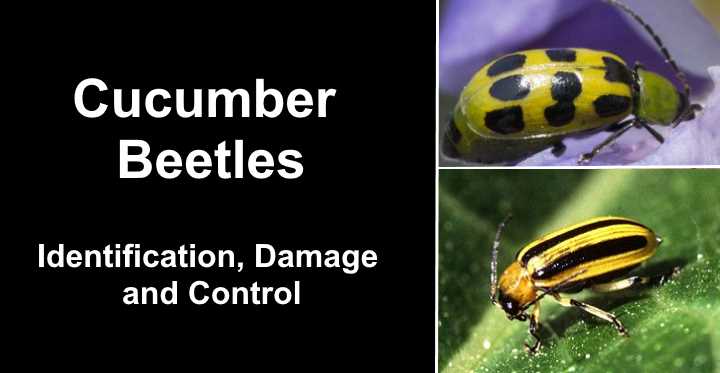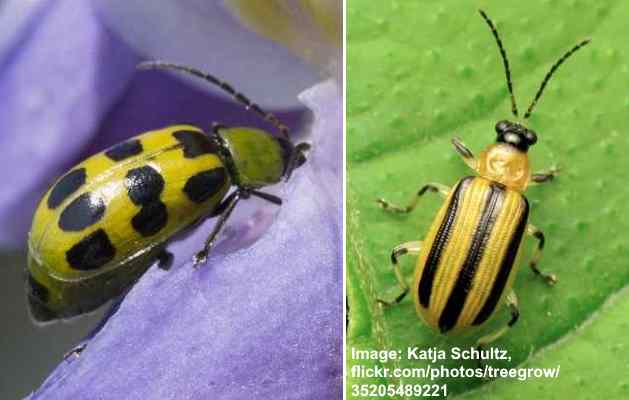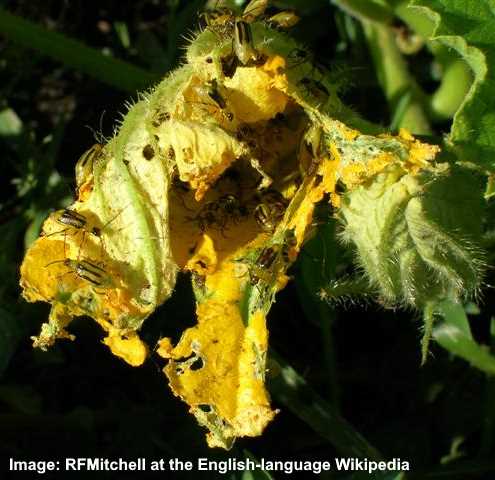Cucumber Beetles (Striped and Spotted): Identification, Damage and Control (With Pictures)

Cucumber beetles are striped or spotted bugs that do damage to various types of crops. You may find the small yellow or orange beetles crawling on plants in the cucurbit family — cucumbers, pumpkins, watermelons, squash, and zucchini. The spotted or striped yellowish-green cucumber beetles eat shoots, flowers, and leaves, eventually killing your vegetables. Therefore, controlling and getting rid of cucumber beetles is crucial if you want to save your crops.
Cucumber beetles are native to North America and tend to begin their destructive activity in June. However, their larvae can already be damaging crops even before the striped or spotted yellow beetles emerge.
Suppose you have noticed several yellow beetles with black stripes on your cucumber plant leaves. Or maybe you have seen greenish-yellow bugs with large black dots on their backs and wonder what to do.
In that case, this article has advice on identifying and getting rid of two pesky bugs that destroy cucumber plants — the spotted cucumber beetle and the striped cucumber beetle.
What Are Cucumber Beetles?
Cucumber beetles are plant-eating, disease-carrying destructive insects that feed on cucurbit crops. The striped and spotted yellow cucumber beetles target plants like cucumbers, squash, eggplants, beans, and melons. The scientific name for the striped cucumber beetle is Acalymma vittatum, and the spotted cucumber beetle is Diabrotica undecimpunctata. Both genera are in the family Chrysomelidae.
What Do Cucumber Beetles Look Like?

Spotted cucumber beetle (left) and striped cucumber beetle (right)
Adult spotted cucumber beetles measure 0.25” (6 mm) long with a yellow abdomen and 12 relatively large black dots. The striped cucumber beetles have similar yellowish wing covers but have three black bands along their back. Both beetle species have six legs, two antennae, and a black head.
Cucumber beetle larvae are hard to spot because they spend most of their life underground munching on cucumber roots. The cucumber beetle larvae look like yellowish-white worms with black heads and grow up to 0.47” (12 mm) long before pupating. They also have three pairs of brown legs near their heads.
Cucumber Beetle Life Cycle
It takes 40 to 60 days from laying an egg until an adult cucumber beetle emerges.
A spotted or striped cucumber beetle starts its life as a tiny oval-shaped yellow egg that the females lay in mid-spring. It takes six to nine days for eggs to hatch in ideal conditions. After the creamy-yellow larvae hatch, they start feeding on the roots of the host plants — cucumbers and other cucurbit crops.
The next stage of a cucumber beetle’s life cycle is pupation. The larvae construct a small chamber in the soil to begin pupation. After six to ten days, small beetles emerge. Depending on the species, the yellow beetles have a spotted or striped abdomen.
After emerging as adults, the cucumber beetles start feeding on leaves, stems, and other plant matter. The adult stage is when the beetles do the most damage. However, cucumber beetle larvae can also do some limited damage to crops.
How to Identify Cucumber Beetle
The two species of cucumber beetle are easy to identify due to the spotted or striped markings on their yellow abdomens. Striped cucumber beetles have three black bands running down the length of their yellow backs. The spotted cucumber beetles have a brightly colored yellow or yellow-green back with 12 black spots.
What Do Cucumber Beetles Eat?
As their name suggests, the spotted and striped yellow beetles eat plant leaves related to cucumbers. Therefore, many crops in the genus Cucurbita are at risk from beetle damage. Aside from cucumbers, these beetles feed on pumpkin, squash, and watermelon foliage. However, cucumber beetles will also eat leaves from cotton, legumes, corn, and soybean plants.
Cucumber Beetle Larvae Damage
Cucumber beetles start feeding on plants during their larval stage in the soil. Although the yellowish-white grubs feed on roots, the larvae do minimal damage to the plant’s overall health. However, controlling cucumber beetle egg and larvae is challenging, making it difficult to protect crops from beetle damage.
Signs of Cucumber Beetle Damage

Cucumber beetle damage
Signs of cucumber beetles damage to crops show up in two ways. First, the adult cucumber beetles feed on plant foliage, creating holes and damaging small plants. Second, cucumber beetles transmit foliar diseases like Pseudomonas lachrymans, which causes bacterial wilt. The holes in leaves make it easy for the bacterium to multiply fast.
There is another way that cucumber beetles damage cucumbers, pumpkins, squash, and melons. The adult beetle activity can scar fruit, making it look unpalatable.
The most destructive plant damage from cucumber beetles occurs while the plants are relatively young. The small cucurbit plants are small enough that adult cucumber beetles can quickly defoliate plants. If bacterial infections occur, the plant’s vascular system is affected, causing it to wilt. Beetles feeding on infected plants can quickly infect other cucumber crops.
Spotted cucumber beetle damage to plants
Adult spotted cucumber beetles damage a broader range of plants than their striped counterparts. The plant-destroying pests can affect over 200 plant species. In addition, they are more of a nuisance in the southern United States. Also, spotted cucumber beetles tend to lay eggs on corn and grasses rather than cucurbit plants.
Striped cucumber beetle damage to plants
Adult striped cucumber beetles usually target cucurbit plants and rarely attack other species. You will also find that the yellow and black striped beetles are prevalent throughout the US, rather than just in the southern states.
Where Do Cucumber Beetles Come From?
Cucumber beetles are found on cucurbit crops and other plants across the United States. The beetles overwinter in compost, trash piles, or crop fields. They then emerge mid-spring from their winter hideaways, where the females will rapidly lay eggs in the soil. Finally, a new generation of cucumber beetles emerges from the base of the plants to start their destructive behavior.
How to Get Rid of Cucumber Beetles
Getting rid of cucumber beetles can be challenging. The small yellow and black spotted or striped beetles can be too tiny to handpick from plants. Additionally, cucumber beetles are most active from late evening until the morning, making them difficult to locate on crops.
Suppose your cucumber plants, watermelon, pumpkin, or squash are reaching maturity. In that case, getting rid of the annoying bugs is not necessary. The beetle damage only affects immature plants, and older crops aren’t affected by defoliation.
Here are some ways you can try and eradicate cucumber beetles if you see the striped or spotted bugs on your cucurbit crops. In many cases, using a multi-faceted approach is best to ensure you reduce beetle populations as much as possible.
Beneficial Insects Kill Cucumber Beetles
Many beneficial insects prey on cucumber beetles and can help get rid of them from your vegetable patch. Natural enemies of cucumber beetles include tachinid flies, harvestmen, braconid wasps, and soldier beetles. There is also some evidence to suggest that bats and predatory mites are excellent biological control methods.
According to some studies, nematodes can effectively kill cucumber beetle larvae before they emerge from the ground and start eating your plants. Therefore, soil-drenching preparations using nematodes in late fall or early spring could help kill larvae and prevent a cucumber beetle infestation.
Neem Oil Can Kill Immature Cucumber Beetles
A homemade DIY neem oil spray could effectively eradicate immature cucumber beetles in mid to late spring. To make a neem oil bug spray, combine 2 tsp. neem oil, 1 tsp. Castile soap and 1 quart (1 l) of water in a spray bottle. Shake well and spray liberally on foliage in the evening. Repeat every seven days to get rid of the beetles.
Neem oil can be effective on bug larvae and immature insects because it contains azadirachtin — a natural pesticide. Research on neem oil extracts says that they disrupt the development of eggs, prevent larvae from developing, and inhibit feeding.
Use neem oil to kill cucumber beetle larvae
Neem oil could also help control cucumber beetle larvae living in the soil. To use this soil drench method, you must apply the solution in early spring. To make neem oil solution, use 2 tbsp. neem oil per 1 gal (3.7l) of water. Then, water your lawn using a hose sprayer or watering can. Finally, water your vegetable patch once a week in spring to kill off cucumber beetle larvae.
Handpick Cucumber Beetles to Eradicate Them
Have you noticed a large infestation of cucumber beetles on your cucurbit crops? If so, you may need to remove the pesky bugs manually. It may be too tricky to handpick individual beetles. However, some gardeners have successfully used a leaf blower/vacuum to suck up large numbers of cucumber beetles from plants.
If you notice signs of bacterial wilt on your crops, you should remove the plants immediately. Beetles feeding on infected plants can easily transmit the bacteria to other plants in your yard.
How to Control Cucumber Beetles
If cucumber beetles have been a problem in your area, vigilance from early spring is vital for controlling beetle populations. Some effective control methods for cucumber beetles include row covers, using mulch or reflective mulches, or applying kaolin clay to the soil.
Use Row Covers for Cucumber Beetle Control
After planting cucumber seeds or other cucurbit plants, it’s vital to use floating row covers to keep beetles away from plants. The ideal time for row covers is from early June. However, this control method is only effective for controlling cucumber beetles until your plants start to flower. This is because you must remove the covers to allow for pollination.
Use Mulch to Deter Cucumber Beetles
Mulch is another way to control cucumber beetle activity and protect your crops. Mulching around crops helps protect the plants in several ways. First, it helps prevent egg laying and subsequent larvae from emerging from the soil. However, mulch also encourages habitats for beetle predators and boosts soil microorganisms which, in turn, promote plant health.
Some studies suggest that reflective aluminum mulch can help reduce the number of cucumber beetles on crops. In addition, the mulch has a repelling action that prevents nasty creatures like aphids and cucumber beetles from feeding on crops. This also helped reduce the transmission of bacterial wilt between plants.
Companion Planting Can Help Control Cucumber Beetle Numbers
One natural way to control cucumber beetles without using chemicals is companion planting. Also called intercropping, this is a method of planting crops that repel cucumber beetles alongside cucurbit plants. Plants acting as a cucumber beetle deterrent include radish, broccoli, and nasturtium.
Another method of using natural beetle control methods includes planting trap crops. This idea is to grow a few squash plants that attract a high number of cucumber beetles. Using this method, you can draw destructive beetles away from your main crop. However, this may not work for all small gardens.
Kaolin Clay Can Help Control Cucumber Beetles
Kaolin clay is a natural cucumber beetle repellent that can help to control populations. Spraying cucurbits with kaolin clay causes a sticky coating to build up on their antennae, making it difficult for them to find their way around your yard.
Studies suggest mixed results from using kaolin clay for cucumber beetle control. However, it may work for your vegetable patch if you use it in conjunction with other control methods.
How to Prevent Cucumber Beetles
The best way to deal with cucumber beetles in your yard is to prevent them from multiplying in the first place. In many cases, crop rotation and planting beetle-resistant varieties of cucurbits can help eradicate problems with cucumber beetles. Here are a few handy methods of ensuring that striped or spotted beetles don’t ruin your crop.
Plant Resistant Varieties of Crops
Some varieties of cucumbers, squash, melon, and eggplants are specially selected to be less attractive to cucumber beetles. These crop varieties have lower levels of the chemical cucurbitacin, which attracts the beetles. Planting these resistant varieties may mean that the beetles go elsewhere searching for food.
Crop Rotation Can Help Control Cucumber Beetles
Rotating crops is a tried and tested method of reducing pest infestation in organic gardening. The issue with cucumber beetles is that they tend to overwinter nearby the previous year’s crop. Therefore, you could try to prevent a beetle invasion by planting next year’s crop away from the previous one.
Although crop rotation is good practice for organic farming without chemicals, it isn’t the single effective method to prevent cucumber beetles from being a nuisance.
Planting Later in the Season
Cucumber beetles are active in mid to late May when they start to lay their eggs. Therefore, planting cucurbit crops in mid-June could help prevent adult beetles from destroying crops. By this time, the peak of beetle feeding has passed, and your crops have a better chance of surviving.
Other Preventative Methods of Eradicating Cucumber Beetle Damage
Here are other ways to significantly reduce the problems cucumber beetles can cause in a vegetable patch:
- Be attentive to cucurbit plants in the initial leaf stages, as this is when most beetle damage occurs.
- Keep removing beetles until fruiting because bacterial wilt can affect larger plants.
- Apply a thick layer of mulch around existing cucumber plants during the growing season to discourage egg laying.
- Remove plants showing symptoms of bacterial wilt before more beetles can feed on them and spread the bacteria.
- Remove garden debris and leaf litter after the summer so that adults cannot overwinter there.
Related articles:
- Effective Ways to Get Rid of Spider Mites
- Types of Beetles – Identification Guide
- Small Black Bugs on Plants – Identification and Control
